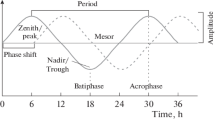Abstract
Age-related features of the ultradian rhythms of the total protein and albumin content in lymph-node tissue have been studied in intact rats and rats exposed to chronic toxic oxidative stress with a chronobiological approach and biochemical methods. During the experiment, the rhythmic activity of the total protein and the albumin content in lymph nodes were compared during ontogenesis and under chronic exposure to a sulfur-containing natural gas. The revealed oscillations in the studied parameters can be characterized as circahoralian (ultradian) with periods of 20–40 to 60 min. The obtained data indicate a decrease in the adaptive resistance of lymph nodes and exhaustion of the antioxidant system in aging rats. These results can be of practical value for the development of methods to correct for the negative effects of a toxic oxidative stress during ontogenesis.




Similar content being viewed by others
REFERENCES
Baraboi, V.A., Brekhman, I.I., Golozhin, V.G., et al., Perekisnoe okislenie i stress (Peroxidation and Stress), Moscow: Nauka, 2004.
Boev, V.M. and Setko, N.P., Sernistye soedineniya prirodnogo gaza i ikh deistive na organizm (Sulfur Compounds of Natural Gas and Its Effect on the Organism), Moscow: Meditsina, 2001.
Brodsky, V.Y., Circahoralian (ultradian) metabolic rhythms, Biochemistry (Moscow), 2014, vol. 79, no. 6, pp. 483–495.
Golubkina, E.V., Dyukareva, O.S., Trizno, N.N., et al., Influence of peroxidation in platelets on the homeostasis system affected by hydrogen sulfide gas, Zh. Med.-Biol. Issled., 2019, vol. 7, no. 1, pp. 40–48.
Dubinina, E.E., Role of reactive oxygen species as signaling molecules in tissue metabolism in stress conditions, Vopr. Med. Khim., 2001, vol. 47, no. 6, pp. 561–581.
Dubinina, E.E., Produkty metabolisma kisloroda v funktsional’noi aktivnosti kletok (zhizn’ i smert’, sozidanie i razrushenie). Fiziologicheskie i klinikobiokhimicheskie aspekty (Oxygen Metabolism Products in the Functional Activity of Cells (Life and Death, Creation and Destruction). Physiological and Clinical-Biochemical Aspects), St. Petersburg: Meditsinskaya Pressa, 2006.
Dubinina, E.E., Burmistrov, S.O., Khodov, D.A., and Porotov, I.G., Oxidative modification and determination of human blood serum proteins, Vopr. Med. Khim., 1995, vol. 41, no. 1, pp. 24–26.
Zaguskin, S.L., Biological time: self-regulation and control, Prostr. Vremya, 2016, vol. 22, no. 4, pp. 254–266.
Mazhitova, M.V., Teply, D.L., Trizno, N.N., et al., Experimental chronic effect of natural gas from the Astrakhan field on antioxidant activity and redox potential of blood plasma and brain tissue, Estestv. Tekh. Nauki, 2011, vol. 56, no. 6, pp. 149–153.
Laboratornye metody issledovaniya v klinike (Laboratory Analysis Methods in Clinical Practice), Men’shikov, V.V., Ed., Moscow: Meditsina, 1987, pp. 175–176.
Men’shikov, V.V., Metodicheskie ukazaniya po primeneniyu unifitsirovannykh klinicheskikh laboratornykh metodov issledovaniii (Methodological Recommendations for Implementation of Unified Clinical Laboratory Study Methods), Moscow, 1973, pp. 45–47.
Rozhkova, I.S. and Teply, D.L., Peculiarities of rhythmic activity of blood plasma proteins in experiment, Sci. Eur., 2018, vol. 2, no. 27, pp. 12–14.
Rozhkova, I.S. and Teply, D.L., Pharmacological correction of the free radical processes in the organs of the immune system on the background of chronic intoxication, Estestv. Nauki, 2016, vol. 54, no. 1, pp. 72–77.
Stal’naya, I.D. and Garishvili, T.T., Determination of malonic dialdehyde using thiobarbituric acid, in Sovremennye metody v biokhimii (Modern Methods in Biochemistry), Moscow: Meditsina, 1977, pp. 66–68.
Stroev, E.A. and Makarova, V.G., Praktikum po biologicheskoi khimii (Practical Manual on Biological Chemistry), Moscow: Vysshaya Shkola, 1986.
Shishkina, T.A., Naumova, L.I., and Davlatova, I.S., Vascular reaction of the wall of the small intestine to the action of anthropogenic factors, Morfologiya, 2018, vol. 153, no. 3, p. 323.
Teply, D.L., The participation of antioxidants in the regulation of neuronal apoptosis of phylogenetically different parts of the brain during aging, Materialy III Vserossiiskoi nauchnoi konferentsii s mezhdunarodnym uchastiem “Svobodnye radikaly, antioksidanty i starenie” (Proc. III All-Russ. Sci. Conf. with Int. Participation “Free Radicals, Antioxidants, and Aging”), Astrakhan: Astrakh. Gos. Univ., 2016, pp. 96–100.
Chernysheva, M.P., Phylogenesis of antioxidant systems, Materialy III Vserossiiskoi nauchnoi konferentsii s mezhdunarodnym uchastiem “Svobodnye radikaly, antioksidanty i starenie” (Proc. III All-Russ. Sci. Conf. with Int. Participation “Free Radicals, Antioxidants, and Aging”), Astrakhan: Astrakh. Gos. Univ., 2016, pp. 113–114.
Yaroshinskaya, A.P., Laz’ko, A.E., and Zindan, S., Influence of sulfur-containing gas on the drainage function of the microcirculation system, Morfologiya, 2016, vol. 149, no. 3, p. 249.
Fukami, K., Sekiguchi, F., and Kawabata, A., Hydrogen sulfide and T-type Ca2+ channels in pain processing, neuronal differentiation and neuroendocrine secretion, Pharmacology, 2017, vol. 99, nos. 3–4, pp. 196–203.
Rao, G., Xia, E., and Richardson, A., Effect of age on the expression of antioxidant enzymes in male Fischer 344 rats, Mech. Ageing Dev., 1990, vol. 53, no. 1, pp. 49–60.
Wallace, J.L. and Wang, R., Hydrogen sulfide-based therapeutics: exploiting a unique but ubiquitous gasotransmitter, Nat. Rev. Drug Discovery, 2015, vol. 14, no. 5, pp. 329–345.
Funding
The study was performed within the framework of the State Assignment no. АААА-А18-118012290371-3.
Author information
Authors and Affiliations
Corresponding author
Ethics declarations
Conflict of interest. The authors declare that they have no conflict of interest.
Statement of animal welfare. All applicable international, national, and/or institutional guidelines for the care and use of animals were followed.
Additional information
Translated by N. Statsyuk
Rights and permissions
About this article
Cite this article
Rozhkova, I.S., Teply, D.L. & Bazhanova, E.D. Ultradian Rhythms and Oxidative Stress in Lymph-Node Tissue during Ontogenesis. Adv Gerontol 11, 268–273 (2021). https://doi.org/10.1134/S2079057021030140
Received:
Revised:
Accepted:
Published:
Issue Date:
DOI: https://doi.org/10.1134/S2079057021030140




